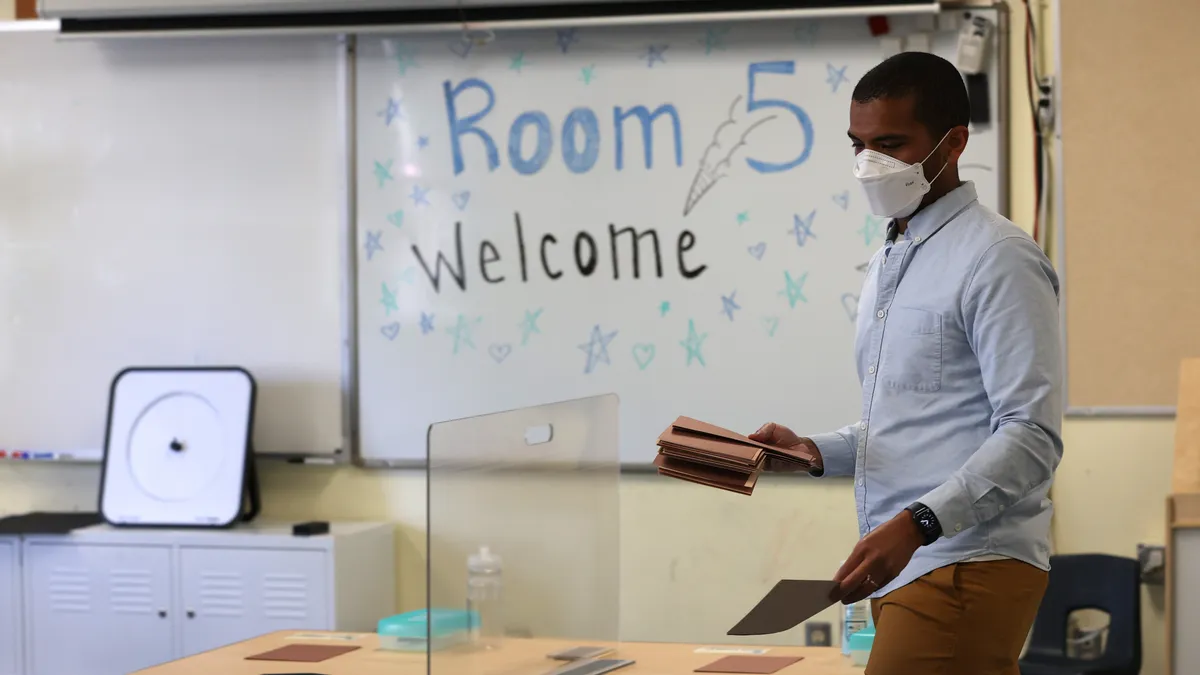Dive Brief:
-
Teacher recruitment, preparation and retention efforts at the state and local levels should include purposeful efforts to diversify the workforce, which research has shown has positive impacts on students, schools and the teaching profession, according to a new Teaching Profession Playbook, published by the Partnership for the Future of Learning.
-
The playbook, developed by 26 organizations including the Council of Chief State School Officers, the American Federation of Teachers and the National Parent Teacher Association, details high-impact strategies and examples for attracting and supporting teachers with a range of identities and experiences.
-
A lack of effective teachers can negatively impact students' ability to learn and hinder schoolwide teacher effectiveness. As schools aim to provide equitable pandemic-related learning recovery services, they should consider using federal emergency funding for teacher workforce incentives and implementing proven teacher recruitment and retention programs, the playbook advises.
Dive Insight:
Teacher shortages, particularly in math, STEM and special education, existed before the pandemic but are expected to worsen as more teachers retire or resign and fewer people enroll in teacher preparation courses, according to education experts.
The Learning Policy Institute, which contributed to the development of the 152-page playbook, wrote an earlier report that said teacher vacancies have increased among California districts during the pandemic, with smaller rural school districts having the biggest challenges. The contributing factors are large workloads and burnout, as well as retirements and resignations, the LPI report said.
Not only are schools struggling to recruit and retain teachers, but they are also seeking to increase the number of teachers with varying racial, ethnic, gender, socioeconomic and disability experiences. Non-White teachers compromise about 21% of public elementary and secondary school teachers nationally, data from the National Center for Education Statistics shows.
"We've always wanted to push to diversify the workforce and I think it's even more prevalent now or more important now because we know the inequities, and we have to help address the learning loss that has occurred and hopefully be able to address the gaps that have occurred, and having a diverse workforce and effective diverse workforce is just one more step in the right direction to do so," said Lynn Holdheide, senior advisor for the Center on Great Teachers and Leaders, which also contributed to the playbook.
Holdheide said even though the development of the playbook began before the pandemic, the global health crisis’s impact on education and the efforts to address racial injustice after the killing of George Floyd in 2020 have made its suggestions even more relevant.
Karen DeMoss, executive director of Prepared To Teach, said the playbook encourages education stakeholders to be bolder and more strategic in finding longer-term solutions to teacher shortages and diversity barriers. "We need to all say this is crucial," DeMoss said.
The playbook promotes strategies like teacher residencies and Grow Your Own programs, as well as educator loan, benefit and compensation programs. As schools develop plans to spend Elementary and Secondary School Emergency Relief Funds, they should consider efforts to create a stable and diverse workforce, the playbook recommends.
"We've never seen this unprecedented amount of funding coming into education," Holdheide said. "How do we make sure that in 10 years we look back and we say, 'Wow, this was used well, and it really helped facilitate innovative solutions that have been shown to have positive effects?'"












